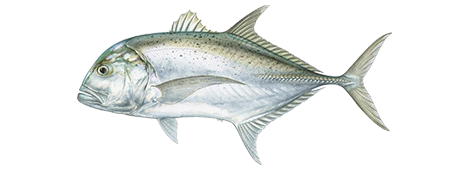Giant Trevally

The giant trevally, which grows to over 130 pounds, is the largest of the eight Caranx species which occur in the Indo-Pacific region.
HOW TO IDENTIFY A GIANT TREVALLY
It has a small oval-shaped patch of scales in the center of the larger scale-free area of the body on the breast in front of the ventral fins, distinguishing it from the bigeye trevally whose breast is fully scaled. In some specimens (about 5%) this oval patch of scales is extensive enough to make detection of the scale-free area difficult. The body and head are usually very deep with a blunt snout. The lateral line is strongly curved anteriorly. The straight portion is covered with scutes; 25-33 in the giant trevally and 28-37 in the bigeye trevally. The first dorsal fin consists of 8 spines, the second of 17-21 soft rays, and an anal fin of 3 spines and 15-17 soft rays. Gill rakers on the first arch total 18-23. There is no spot on the operculum such as is found on the bigeye trevally, nor is there a spot at the base of the pectoral fins such as appears on the crevalle jacks, the close Atlantic and eastern Pacific relatives of this species.
WHERE TO CATCH GIANT TREVALLY
The giant trevally inhabits coral and rock reefs in warm coastal waters of the Indian and central Pacific Oceans, eastward to the Hawaiian and Marquesas Islands. This fish is very common in the waters off Kenya and other parts of Africa as well as off Australia, New Zealand, the Philippines, Malaysia, and Hawaii. This is the most common of the trevallys found in Hawaii’s and Kenya’s waters. The following list includes additional details on where to catch this fish:
BAITFISH PATCHES COASTAL WATERS
MERGING WATER REEFS, WRECKS, AND SHOALS
SHORE POINTS CLIFFS
DEEP SHORE WATER NIGHT FISHING
ROCKY SEA FLOOR SURF AND SHORE
HOW TO CATCH GIANT TREVALLY
Adults are sedentary, prefer rocky areas near shore or outside reef drop-offs, and feed most actively at night. Hawaiian anglers report that the darker the night the more actively the giant trevally will feed. It is a highly rate sport fish in the waters of Hawaii and Kenya both for its large size and the tough fighting ability it possesses. Fishing methods include surf fishing, drifting, or still fishing using live or cut baits. Trolling with baits and lures can also produce good results. Baits and lures include mullet, herring, sauri, garfish, anchovy, squid, cut strip baits, jethead trolling lures, trolling feathers, plastic jigs, and spoons. The pinkish flesh is highly esteemed as food in some areas and is also frequently used for strip baits, cut baits or chum. The following are fishing methods used to catch this fish:
JIGGING FLY FISHING BAIT CASTING
STILL FISHING SALTWATER TROLLING DRIFT FISHING
BOTTOM BOUNCING SURF CASTING SPIN CASTING
GIANT TREVALLY LURES, TACKLE & BAIT
The following are lures, tackle or bait that can be used to catch this fish:
CUT BAIT JIGS SALTWATER LIVE BAIT
SPOONS TROLLING LURES FLIES
PLUGS SOFT PLASTICS SQUID